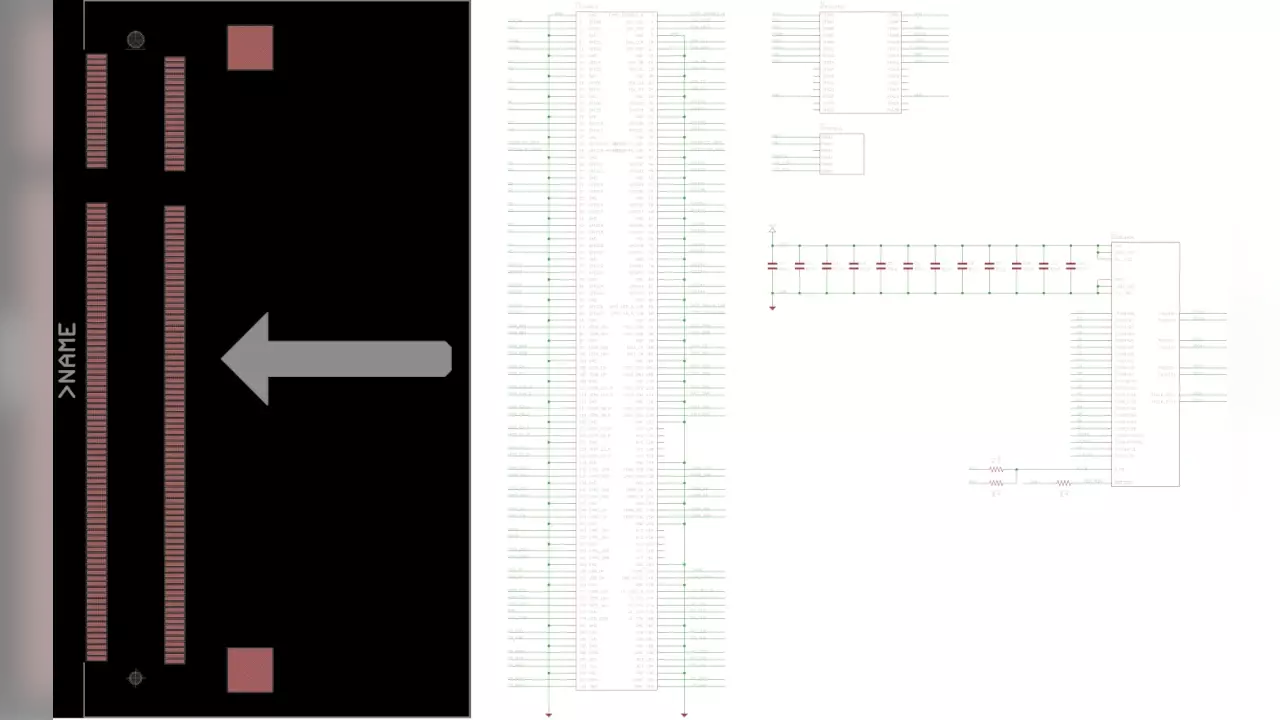Related Topics
Timing Tariff Modulations
We delve into the fascinating world of time modulation, discussing recent advancements in capacitor technology.
No David Here, Chris Gammell with Golioth.io
We welcome Chris Gammell, Developer Relations Lead at Golioth, to explore the exciting world of IoT (Internet of Things) and hardware.
Net Running the Nut Runners with Joe Grand
Bosch wrench hack sparks talk on insecure IoT devices. We discuss safety risks and broader implications.
Other Resources
Circuit Break Podcast
Webinars
Videos
Tour MacroFab's ITAR-Compliant Facility
April 7, 2017, Episode #62
- If you enjoy listening to MEP, please let others know about us! Tell a coworker, loved one, friend, or share it on “social media”. We might reward your love for us by sending you a free koozie! Tell others how much you love us, then send us an email to podcast@macrofab.com with the codeword that we’ll mention during the show, plus your mailing address. Each show has a different codeword, so keep an ear out!
- MacroFab and Mouser Electronics have teamed up to create a free monthly meetup in Houston (April 26th) for anyone involved with hardware & electronics engineering or manufacturing. Hosted on the last Wednesday of every month, these meetups are designed to build a community of professionals who want to learn from one another, gain new insights on emerging electronics technologies, and expand their network.
- Sign up here!
- What to expect
- Networking
- Fireside chats with Q&A
- Individual project sharing and discussion
- Door prizes
- Refreshments
- Parker has been working on the next step of the RPI3 LVDS project.
- Pinout the SODIMM connector for the RPI3 Compute Module. See Figure 1.
- Part number 1473149-4 by TE Connectivity
- LVDS DS90C365A IC is net listed up
- Trying to use the PWM function to control the backlight of the LCD.
- GPIO40 is PWM0 on the RPI3
- Still to be done
- Power 1.8V, 3.3V, 12V
- SD card
- HDMI
- USB and a USB Hub
- Break out all the pins
- Test points for clk signals and data streams
- Pinout the SODIMM connector for the RPI3 Compute Module. See Figure 1.
- Stephen has a challenge for the listeners.
- Goal: Design for a ring of LEDs that surround a control knob on a synthesizer and light up according to the position of the knob
- Requirements
- The circuit must connect to a potentiometer (this can be a dual gang version) example: rv16a01f
- The ring of LEDs must be centered on a 12mm radius around the potentiometer.
- Whole circuit must not be larger 1.2” W x 1.2”H x 1.2”D
- PCB can solder directly to pins on potentiometer
- Multiple PCBs is acceptable if needed
- Color of the LEDs does not matter although green or red is preferable
- Number of LEDs is 16 minimum and 32 maximum
- LEDs are arranged on a 300 degree arc (potentiometer has 300 degrees of rotation) starting at 240 degrees and ending at -60 degrees
- The circuit will receive external 5V power so it must have through hole pads for power and gnd
- CHEAP CHEAP CHEAP! Do this for as cheap as possible
- Rapid Fire Opinion (RFOs)
- Revealing Capcom’s Custom Silicon Security – Hackaday
- Capcom developed their arcade boards to die with their secrets through a “suicide” system. System name CPS2
- Basically all the game code was encrypted and the key was stored in volatile ram kept alive by a battery.
- Reminds Parker of the reflow oven that MacroFab currently use.
- NXP chip checks your booze – Electronics Weekly
- The Tag uses NXP’s NTAG 213 Tag Tamper technology which checks the origin of the bottle, detects if the bottle has been opened, and creates an URL for the bottle.
- Stick it on, and if someone tries to remove it, the NFC chip will separate from the tag, rendering it unusable.
- Example Tag that uses the NTAG213
- Datasheet
- IoT Startup Bricks Customers Garage Door Intentionally – Hack A Day
- Garadget remotely bricked an unhappy customer’s WiFi garage door for giving a bad Amazon review and being rude to company reps.
- “Technically there is no bricking, though,” the rep replied. “No changes are made to the hardware or the firmware of the device, just denied use of company servers.”
- What happens when this fine firm to go bankrupt? Do all their openers stop working?
- Revealing Capcom’s Custom Silicon Security – Hackaday
About the Hosts

Parker Dillmann
Parker is an Electrical Engineer with backgrounds in Embedded System Design and Digital Signal Processing. He got his start in 2005 by hacking Nintendo consoles into portable gaming units. The following year he designed and produced an Atari 2600 video mod to allow the Atari to display a crisp, RF fuzz free picture on newer TVs. Over a thousand Atari video mods where produced by Parker from 2006 to 2011 and the mod is still made by other enthusiasts in the Atari community.
In 2006, Parker enrolled at The University of Texas at Austin as a Petroleum Engineer. After realizing electronics was his passion he switched majors in 2007 to Electrical and Computer Engineering. Following his previous background in making the Atari 2600 video mod, Parker decided to take more board layout classes and circuit design classes. Other areas of study include robotics, microcontroller theory and design, FPGA development with VHDL and Verilog, and image and signal processing with DSPs. In 2010, Parker won a Ti sponsored Launchpad programming and design contest that was held by the IEEE CS chapter at the University. Parker graduated with a BS in Electrical and Computer Engineering in the Spring of 2012.
In the Summer of 2012, Parker was hired on as an Electrical Engineer at Dynamic Perception to design and prototype new electronic products. Here, Parker learned about full product development cycles and honed his board layout skills. Seeing the difficulties in managing operations and FCC/CE compliance testing, Parker thought there had to be a better way for small electronic companies to get their product out in customer's hands.
Parker also runs the blog, longhornengineer.com, where he posts his personal projects, technical guides, and appnotes about board layout design and components.

Stephen Kraig
Stephen Kraig is a component engineer working in the aerospace industry. He has applied his electrical engineering knowledge in a variety of contexts previously, including oil and gas, contract manufacturing, audio electronic repair, and synthesizer design. A graduate of Texas A&M, Stephen has lived his adult life in the Houston, TX, and Denver, CO, areas.
Stephen has never said no to a project. From building guitar amps (starting when he was 17) to designing and building his own CNC table to fine-tuning the mineral composition of the water he uses to brew beer, he thrives on testing, experimentation, and problem-solving. Tune into the podcast to learn more about the wacky stuff Stephen gets up to.
Special thanks to whixr over at Tymkrs for the intro and outro!
Related Podcasts

Captured Pads
Parker & Stephen dive into Circuit Break Discourse, LT3073 regulator, Weldestroyer updates, Box Truk progress, and more!

No David Here, Chris Gammell with Golioth.io
We welcome Chris Gammell, Developer Relations Lead at Golioth, to explore the exciting world of IoT (Internet of Things) and hardware.

Holy Static Hazard Batman!
Parker and Stephen discuss a recent article exploring how electrostatic discharge damage isn’t the only kind of static hazard digital designs can face.

Net Running the Nut Runners with Joe Grand
Bosch wrench hack sparks talk on insecure IoT devices. We discuss safety risks and broader implications.

Timing Tariff Modulations
We delve into the fascinating world of time modulation, discussing recent advancements in capacitor technology.

Duke Nukem v. Parker, Raspberry Pi 5, Weldestroyer!
Parker’s charity work, in which he plays video games like Duke Nukem. Plus, deep dive into the Raspberry Pi 5 and Stephen updates about Weldestroyer 3000.
About MacroFab
MacroFab offers comprehensive manufacturing solutions, from your smallest prototyping orders to your largest production needs. Our factory network locations are strategically located across North America, ensuring that we have the flexibility to provide capacity when and where you need it most.
Experience the future of EMS manufacturing with our state-of-the-art technology platform and cutting-edge digital supply chain solutions. At MacroFab, we ensure that your electronics are produced faster, more efficiently, and with fewer logistic problems than ever before.
Take advantage of AI-enabled sourcing opportunities and employ expert teams who are connected through a user-friendly technology platform. Discover how streamlined electronics manufacturing can benefit your business by contacting us today.
